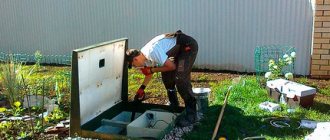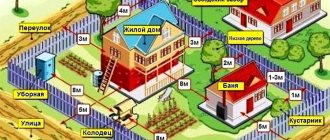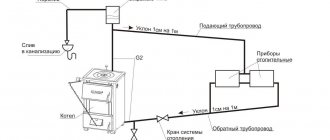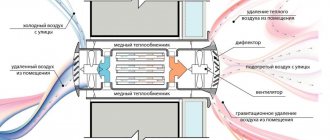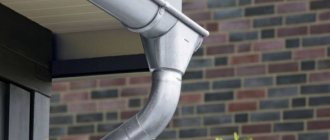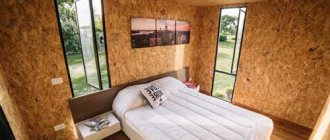Review of various schemes of water heating furnaces
One of the simplest stove designs with a U-shaped heat exchanger installed directly in the firebox. The heater with flat surfaces is made of 4 mm thick sheet metal; it is better to use heat-resistant steel. Another option is a coil in the form of a register, welded from pipes (possibly water and gas pipes) with a nominal diameter of 50 mm and a wall thickness of at least 3.5 mm. The figure shows a diagram of a water-heated furnace of a similar design.
Drawing of a stove with a built-in heat exchanger for water heating
1 – heat exchanger in the combustion chamber; 2 – door for cleaning chimneys; 3 - supply to the heating system.
The principle of operation here is simple: a steel register with a coolant is heated directly from the flame in the firebox, and the combustion products rush upward and make 3 strokes, simultaneously giving off heat to the brick walls and oven for cooking.
A slightly different stove for a home with water heating is a dual-purpose hob with a heater built into the firebox. The stove does not have long chimney channels, since it provides for the extraction of heat from combustion products by a water heat exchanger. The dimensions of the heat source are 1030 x 650 x 780 (height), the heater power is about 9 kW. The latter is made of pipes with diameters of 57 x 3 mm and 48 x 3 mm. The design of the furnace is shown in the photo.
Oven with hob
1 – firebox; 2 – ash chamber; 3 – door for cleaning; 4 – oven; 5 – hob; 6 – clay solution; 7 – water heater; 8 – chimney channel; 9, 10 – respectively, return and supply pipelines of the heating system.
The fuel, when burned, heats the coil directly. Additionally, it is heated by flue gases, which then enter the channel between the hob and oven, go around the latter and are discharged through the chimney. The heated coolant circulates from the register into the system, and the impulse can be either natural or forced. Thus, the water heater removes heat from the firebox and combustion products, cooling them to 150-200 ºС, due to which water heating from the stove is realized.
Despite all the advantages of such a design, there is an irrational grain in its work. The fact is that the combustion products, from which the hob warms up, are strongly cooled by the heat exchanger. It turns out that during cooking it is necessary to reheat the stove in order to warm up the hob, and at this time the water heating of the house will function at full capacity, and this is irrational and uneconomical. To limit the temperature of the coolant, you will have to install a buffer tank - a heat accumulator, otherwise in the autumn-spring period the rooms will become unbearably hot.
The two-chamber wood-burning stove with water heating by K. A. Dmitriev is devoid of the significant drawback described above and is considered the most common option in central Russia. It has separate chimney channels and two separate fireboxes - one for heating the oven and cooking floor, and the second for water heating from the stove. Separate chimneys at a height of 2 m are combined into one. The overall dimensions of the stove are 1500 x 680 x 770 mm (height), the developed thermal power is 9.5 kW, which is already significant, since it is enough for a house with an area of 100-120 m2. The design can be studied in detail using the drawings.
Structural diagram and cross sections of the furnace
1 – ash chamber; 2, 5 – combustion chambers; 3 – oven; 4 – ash pan door; 6 – cooking floor; 7, 8 — connection to water heating; 9 – heat exchanger; 10 – valve.
When the first firebox is operating, flue gases wash around the metal oven and enter the flue located underneath it. The water heater is not involved in the process, so this mode is convenient in the summer and transition period. In the cold season, a second chamber is heated, which is used only to heat a private home and does not affect the operation of the hob and oven. This version of the brick stove is optimal and economical, showing good results in the efficiency of burning solid fuels (efficiency - 50-55%).
Principles of heating operation
Heating based on a stove with a water circuit works on the principle of heat exchange. In the furnace firebox, hot air heats the water in the circuit. It rises up the pipe and is sent to the heating system. When the coolant enters the radiators (batteries), it gives off its thermal energy, and the cooled liquid flows back into the furnace circuit. This ensures a closed cycle of the system.
There are 2 main types of this heating:
- Gravity system. In accordance with physical laws, heated water rises and rushes into the heating circuit on its own, making room for the already cooled liquid. Such a system can function well with a small number of radiators and a short total pipeline length.
- Compulsory system. In radiators and as it moves through pipes, the water flow experiences significant resistance, which slows it down. In branched and fairly long systems, the own pressure is often insufficient, and therefore it is necessary to ensure forced movement of the coolant. To do this, an electric pump is installed (most often in the return pipe).
Design features of the furnace
A furnace for water heating differs from a conventional one in that a water circuit (heat exchanger) is built into it. It contains 2 pipes: at the top - for supplying hot water to the system, at the bottom - for connecting the return pipe with cooled liquid. The furnace's design must ensure heating of the coolant passing through the pipes.
The efficiency of the furnace is ensured by the correct choice of circuit design and its location, taking into account the following features:
- Design. A furnace heat exchanger can be made of sheet metal in the form of containers (boilers), round or profile metal pipes, complex metal structures (for example, a heating battery).
- Material. The water circuit is made only of metal. Cast iron is ideal for strength and corrosion resistance, but it is difficult to process. The most commonly used steel pipes or sheets. You cannot use copper in the furnace firebox, because... its melting point is less than 1100ºС, and short-term heating in a wood-burning oven is possible up to 1200ºС.
- Dimensions. The volume and length of the circuit must provide hot water to the entire heating system, taking into account its gradual cooling in each radiator. It is quite difficult to accurately calculate the dimensions of the heat exchanger, and therefore this process is entrusted to specialists. You can estimate the size based on the required power of the heating system. Practice shows that sufficient heating power is 1.1-1.3 kW for every 10 m² of room area with standard ceilings (height 2.7-2.8 m). The heat exchanger, on average, delivers 6-8 kW of energy from each 1 m² of area.
The location of the circuit in the furnace is also important:
- The most efficient heating of the coolant is ensured by placing the circuit directly in the combustion chamber. This option is installed during the construction of a new furnace or major reconstruction with complete disassembly.
- To increase the durability of the heat exchanger, it can be separated from the firebox by a thin partition with good thermal conductivity. In this case, direct contact with an open flame is eliminated, and the requirements for the exchanger material are reduced. In this case, more thermal energy will be required for heating.
- The significant thermal energy of the exhaust smoke can be harnessed. Installing a circuit in the chimney system eliminates the need to reduce the useful volume of the combustion chamber.
Various types of stoves are used for water heating. In private homes, brick stoves with a built-in water circuit are popular. In small houses, you can use long-burning pyrolysis stoves. Nowadays, you can simply install a purchased, ready-made furnace with a water circuit.
Gas generator furnaces
Gas generator furnaces have a number of distinctive features:
- Economical. The stove operates for about 12 hours on one load of fuel.
- Compact sizes.
- High efficiency - about 85%.
- Possibility of adjusting combustion intensity.
- Possibility of using different types of fuel.
- Easy to connect water circuit.
It would seem that the choice in favor of gas generator furnaces is obvious. But before installing such a model, you need to evaluate a number of nuances:
- Essential requirements for the installation of a chimney.
- There is a high probability of condensation forming on the chimney walls.
- Manual adjustment takes some getting used to. Only in this case can all the above benefits be achieved.
- You can use different types of fuel, but there are a number of requirements, non-compliance with which can lead to a deterioration in the quality of heating.
How to build a water stove at home
- There are three ways to do stove heating with a water circuit with your own hands:
- buy a steel stove from a manufacturer whose services include system installation;
- hire a craftsman - a specialist will select the material, make the device, lay out the stove and install the boiler;
- do it yourself.
How to make such a stove yourself
The principle of a boiler for water heating
Can you make such a system yourself? Quite, just experience in welding and bricklaying when building a furnace is enough. First you need to prepare the boiler (register, coil, heat exchanger).
You can buy such a device or make it yourself using sheet iron and pipes. Since the full process of manufacturing and installing a water circuit cannot be summarized in a short review, the main recommendations are presented below.
Manufacturing options and recommendations
Water heating from a wood-burning stove - diagram
For the boiler, a sheet of metal with a thickness of at least 5 mm is used, and its design is made in such a way that there is maximum heating of the water for further circulation. The boiler, welded from sheet steel, is easy to manufacture and operate – it is easy to clean.
But such a heat exchanger has a smaller heating area, unlike a pipe register. It is difficult to make a pipe register at home yourself - you need an accurate calculation and suitable working conditions; usually such boilers are made to order by specialists who themselves install the system on site.
The simplest method of a solid fuel heat exchanger is a regular potbelly stove with a built-in water system. Here you can take a thick pipe as a basis, then there will be much less welding work.
Attention! All welding seams must be made double, since the temperature in the firebox is not lower than 1000 degrees. If you weld ordinary seams, there is a chance that this place will quickly burn out
Complete the register drawings in accordance with the dimensions of the stove at home. The layout of the rooms of the house and the arrangement of furniture also need to be taken into account.
Here you need to pay attention that it is better to choose a scheme with sheet-metal boilers - they do not have pipe bends connected into one continuous circuit. It is not so troublesome to build such a structure
It is also convenient because after installation you can use the hob without any problems, which is not the case with some tube boilers.
Register made of smooth pipes - drawing
When the coolant moves by gravity, you need to raise the expansion tank higher and use larger diameter pipes. If the pipes are of insufficient size, then you cannot do without a pump, since there will not be good circulation.
Boilers equipped with pumps have their pros and cons: you can save money by installing pipes of a smaller diameter and not raising the system so high, but there is one significant disadvantage - when the electricity is turned off or the circulation pump burns out, the heated boiler may simply explode.
It is better to assemble the structure at home, on site, since the device, like individual parts, has a very large weight and dimensions.
System installation
Heat exchanger made of cast iron battery
- Before installation, a solid foundation is poured, on top of which it is better to lay a layer of brick.
- The grate can be laid at different stages: before the boiler, if there is a double structure, the lower part of which can be equal to or higher than the upper part of the grate, when the stove is low and the system is placed a little higher, then the grate, doors, corner on the stove are usually installed after installing the boiler .
- The housing is installed - usually it consists of two containers connected to each other by pipes.
- The entire heat exchange system is welded to the boiler: the exhaust pipe goes to the expander, goes in a circle, through the radiators, and on the other side the return pipe is welded to the boiler from below.
Stove heating with a water circuit allows, firstly, to use firewood much more rationally, and secondly, to evenly distribute warm air throughout the heated room.
If you decide to make your own heating system at home with a water circuit using wood, think through all the stages of the work, and if you have doubts about the successful outcome, it is better to contact specialists.
Satellite heating system
Knowing the tenacity and perseverance of our craftsmen, we are not afraid to assume that there will be those who, organizing stove heating with a water circuit with their own hands, will install a damper that operates in automatic mode. Such a damper, which shuts off the circuit in the absence of circulation, is equipped with an emergency power system, pressure and temperature sensors, and at the same time checks its operation via satellite with an Internet connection. Everything is possible. You just need to understand one simple thing: there are ideas of people who want to save money, and there is a sober engineering calculation, in which all the options in which the developed system may end up are worked out, sometimes, perhaps, futuristic, but, as practice shows, completely justified. To more clearly demonstrate what happens when heating stoves with a water circuit are installed with your own hands without solid calculations and emphasis on reality, we will give one small example from life.
Principle of operation
Units with a water circuit are equipped with a heat exchanger built into the firebox or chimney duct. There are models that can operate in steam circulation mode.
A wood heating stove can be made of boiler steel or cast iron, designed to operate under high steam pressure. These devices are used both as additional equipment and as the main heat source.
A heat exchanger is installed inside the furnace unit. Heated gases move through the channels of the heating reservoir, transferring heat to the liquid. A furnace with a boiler in its design can have several tanks at the same time, which can significantly increase its efficiency. Water is heated in one tank, and with increased heating, the process of vaporization occurs in the second.
To heat a large building with traditional furnace heating, several furnaces will be required, and the consumption of coal or fuel will be quite high. Therefore, a more economical and alternative option would be a stove for water heating a house using wood, equipped with a special hot water boiler built into the firebox. Even in severe frosts, heating the stove twice a day is enough for such a heating system.
Such devices are capable of heating the building even during breaks between fireboxes. During the cooling process, the pipelines give up their heat for another 5-6 hours, thereby providing heating without consuming fuel. Water heating from a wood-burning stove has an efficiency of 80-85%.
Advantages of a water circuit
Heating system
A conventional wood-burning stove distributes heat unevenly - it is hot near the firebox, and the further from the stove, the colder it is. It’s uncomfortable at home because the temperature is different everywhere: I went to watch TV and it was cool, but I came to the kitchen to warm up. With water heating at home there are no such inconveniences; on the contrary, all the heat is distributed evenly throughout all rooms.
In addition, the stove can not only heat, such wood-burning heating is usually installed above the hob stove, that is, you can cook, which increases efficiency. A stove with a water circuit is, in fact, a solid fuel boiler, but here, in addition to the built-in system, the stove itself and the chimneys additionally bring heat into the house, which remain heated for a long time even after the combustion is completed.
Furnaces with a water circuit are widely used in rural areas where there is no gas supply. When choosing water heating, you do not need to buy an expensive industrial gas boiler. A wood boiler is an economical way to heat your home.
Tips for setting up the system
At their core, such designs are the progenitors of modern solid fuel boilers. But unlike them, heat transfer is carried out not only through piping and a radiator system, but also from the stove itself.
Plus, installing brick stoves with water heating yourself is much easier and cheaper than installing a solid fuel boiler.
A few words about the register
Without exaggeration, the metal register can be considered the heart of the entire heating system. This design is installed directly in the firebox itself and is responsible for the heating level of the coolant.
Lateral arrangement of registers.
The simplest and most affordable option is to install a rectangular metal tank directly into the firebox. Such a tank is made of heat-resistant steel, with a thickness of 3 mm or more, most often from stainless steel.
To heat a house of 200 m², a tank 750 mm long, 500 mm wide and 300 mm high is sufficient. The outlet is made from the top of the structure, the return line cuts into the bottom of the tank.
Registers welded from stainless steel pipes with a wall thickness of at least 3 mm are considered more functional. In this case, the heating area increases several times, hence the efficiency of the system is disproportionately higher.
Advice: it is not difficult to find cast iron registers on the market now; according to most experts, they are the best option. Firstly, cast iron is little susceptible to corrosion, practically does not burn out, and most importantly, this material is considered the best heat accumulator.
Stainless steel registers.
During installation, pay attention to the location of the register. The more contact with fire, the higher the productivity
But at the same time, regardless of the configuration of the tank, there must be a compensation gap of at least 5 mm between it and the walls of the furnace. Otherwise, during heating, the metal will begin to expand and the walls of the firebox will crack.
Diaphragm tank
Installing a register into the firebox is only part of the story; it is equally important to properly arrange the piping. Any heating system built on this principle must be equipped with an expansion or membrane tank
As a rule, it is installed on the return pipe, but this is not important; some craftsmen prefer to mount it at the highest point of the system.
Operating principle of a membrane tank.
In a system with natural coolant circulation, its function is performed by an ordinary metal container. But now, in most cases, owners prefer to install circulation pumps. It is advisable to install a real membrane tank in such a system.
The device is a sealed metal container, in the upper part of which there is a valve. Air is forced through the valve, creating excess pressure in the system. As the temperature rises, the coolant expands proportionally, squeezing the excess into the membrane tank. During the cooling process, the air that presses on the membrane compensates for the pressure drop in the system.
Some aspects of laying a furnace
As mentioned earlier, you can build water-heated brick stoves with your own hands, but if you are not confident in your abilities, it is still better to invite a specialist.
Although in any case, there are general rules that it is not advisable to break.
- All brick ovens are made of solid red brick. It is not advisable to use hollow brick even for cladding. The fact is that hollow blocks are a heat insulator, and in this case this can only do harm.
- If you plan to burn with wood, then the firebox can be made of ordinary baked brick. But if there is a possibility of using coke or high-grade coal, such as anthracite, then we would advise making the firebox from special fireclay bricks, which are used in the construction of blast furnaces.
- There is no need to save on wall thickness; in addition to the weight of the oven itself, the load from the registers will also be added here.
- And yet, any stone structure needs a reliable foundation; as for stoves, the foundation should be laid separately and in no case should it come into contact with the general foundation of the house, the minimum distance between them should be 50 - 100 mm.
Circulation pump in the system.
The video shows some of the intricacies of installing the system.
In this case, we were talking about heating a house. But it is worth noting that if a metal water container is inserted into the system in parallel, it will act as a passive boiler, as a result of which hot water will still appear in the house for domestic needs.
Features of masonry
It is impossible to give a definite answer to the question of how to make a brick stove with a boiler with your own hands, since there are many manufacturing schemes. However, we will give you an explanation for one of the popular orders.
The 1st row is made of continuous masonry with the exception of one hewn brick, which is necessary to form a slight slope towards the ash pit.
In the 2nd row (and all subsequent ones), the seams are carefully bandaged, and the blower door is also installed.
The 3rd row is the level at which the first blower door is installed.
The 4th row is difficult to lay out based only on the order. First, another cleaning door is installed here on the right side of the oven. Secondly, here it is necessary to make a support for the oven from half a brick, and also mount a pair of grates.
On the 5th row, cleaning holes or even doors are left. If you opted for cleaning doors, then they are fixed in the masonry at the same time as the installation of the boiler. The top of the boiler should be at the exit of the pipe through which hot water is “supplied”. This location is not accidental: this way you can reduce the risk of airing the system.
On the 6th row the combustion door is fixed, and on the 7th row the cleaning doors are closed.
The 8th row is laid with alternating seams and it also closes the two chimneys located behind the boiler.
From the 9th to the 12th rows are placed the same way. The only thing you need to keep in mind is suture dressing.
The 13th-15th rows are laid out of refractory bricks. This condition is mandatory! These three rows of masonry cover the heating chamber, and the 16th row serves as an additional ceiling.
On the 17th row, it is worth deciding on the dimensions of the horizontal rows of the upper heating chamber. And at the same level you need to install four cleaning doors.
The 18th row finally closes the horizontal channel.
And the 19th row covers the previously installed cleaning doors.
The importance of the 20th row is that the dimensions of the chimney are determined here.
Further, up to the 30th row, the masonry is carried out according to the proposed order with bandaging of the seams.
On the 37th or 38th row, you need to close the roof of the stove structure and install a smoke damper.
From the 39th row you can start laying the chimney.
Furnaces with two-pipe water heating systems, in which an expansion tank is mounted at the top point, have proven themselves to be excellent. The fact is that the expansion tank compensates for the increase in coolant volume during temperature changes in it.
System Features
A conventional brick stove consists of components such as a combustion chamber, an ash pan, grates and chimneys. These components of a simple Russian stove are probably familiar to any village resident. Visually, modern types of stoves are practically no different from traditional village designs.
Main characteristics of water-heated furnaces
Traditional ovens have the following characteristics:
- A simple village stove can produce more than 6500 Kcal of heat in one hour. This amount of heat is quite enough to heat a house with a small area. Such a heating system would be an ideal solution for a small country house. A water-heated furnace, in which the main component is a water boiler, will be approximately 2.5 times more efficient. Using such a heating system, you can heat a house with a much larger area. In order to heat a house, the same amount of fuel will be required, which means that such a system will be more economical.
- A heating system that combines a stove and a boiler will also be effective. If both systems work simultaneously, their productivity increases many times over. A tandem of two such heating systems can release more than 21,000 Kcal of heat in one hour of operation. This amount of heat is enough to heat a house with an area of up to 300 square meters. meters.
Stove connected to water heating
- Most often, such a heating system uses fuel such as coal or wood. The price of such fuel is not high, and its transportation should not cause any particular difficulties. Firewood can be combined with coal at the same time.
- There is no need to constantly heat water-heated stoves. Fuel can be added to the stove several times a day. You can create comfortable conditions indoors, no matter what the weather or temperature is outside.
- If we compare the efficiency of traditional stove heating with a combined system, this figure will increase from 50% to 85%. For heating with wood, this figure can be called ideal.
- The materials that are necessary to organize such a heating system are quite affordable and are not included in the expensive price category.
Disadvantages of water-heated stoves
Stove heating also has its disadvantages, and it would be unfair not to list them.
A brick stove with water heating can be installed not only in a rural or country house, but also in luxury cottages. Typically, owners of luxury homes strive to ensure that such a water heating stove, in addition to its usual functions, also plays a decorative role. During operation of such a combined system, it is necessary to follow some safety and system care rules:
A stove for water heating at home must be under human control at all times.
This applies not only to the issue of loading fuel, but also to cleaning the ash chamber. Smoke ducts also require attention. Before starting a fire in the lever, you must make sure that the smoke channel valves are in the open position. Such systems can only be used in the cold season
During the warm season, using such a heating stove with a water circuit for cooking will be impractical. If you need to cook food, it is better to use another alternative heat source for this purpose.
If you want to make custom-made stoves for water heating at home, it is better to turn to professionals for help. If your stove is manufactured by an unqualified person, there is no guarantee that the stove will function properly or be completely safe. Overheating of the oven can cause some problems that will eventually lead to complete breakdown of the oven.
A conventional stove is usually designed to heat a small room
Since the flame has high temperatures, it will eventually damage the integrity of the boiler walls. This means that the time will come when the heat exchanger will need to be replaced. This is not so easy to do, since you need to remove a good part of the masonry.
Types of systems
A forced circulation oven warms up the room more efficiently and quickly
A brick stove with a water heating boiler, made by yourself or purchased, can operate on a system with forced or natural circulation. Each of the two types has its own characteristics and differences that need to be taken into account.
Forced circulation
A system of this type is complemented by a circulation pump, which is responsible for moving the coolant through the chimneys. By connecting the system to electricity, the pressure level in the radiator can be controlled using valves. This also makes it possible to reduce the amount of fuel for heating the coolant. Forced circulation is quite economical, but its main disadvantage is its dependence on power supply. If there is a power outage, it will not work.
Natural circulation
With natural circulation, it is impossible to regulate the temperature; in addition, the system is difficult to install
A natural circulation system operates by applying the laws of physics. During operation, the coolant moves through the pipes due to differences in the density of cold and hot water. The main advantage of the system is energy independence, which is why it is often created in homes where power outages occur. Among its disadvantages, they note the need to use heavy metal pipes, for example, cast iron, which are difficult to install. Also, the system does not have the ability to regulate the heating level of each room.
A stove or fireplace with a water circuit can be made of cast iron, steel or brickwork. The owner of the house chooses the appropriate option. When choosing, take into account the total area of the premises that need to be heated, the power of the device, the amount of space allocated for the stove, the location of each element of the circuit, the functions of the unit and its design. In addition to these parameters, you need to remember the need to install a special foundation under the stove.
Integrating a stove into an existing heating system
If you already have a heating system that has previously been used with a different type of heating, you can connect a furnace to it. For example, it can become a replacement for a gas boiler.
Modern heating equipment usually does not contain a heating tank. But, it has a heat exchanger that performs a similar function.
The cost depends on a lot of factors - material, size, efficiency, maximum permissible heated area, etc. Moreover, there are models that allow not only to heat the house, but also to provide a full-fledged hot water supply system.
Factory stoves usually allow the use of both classic wood and coal, and pellets, which is a compressed wood material used as fuel.
Instructions for building a stove heating system with a water circuit
- A hole is being dug.
- A “cushion” is laid, consisting of broken bricks, crushed stone and medium-sized rubble. The width of this layer is approximately 20 cm. Natural materials are compacted and filled with cement mortar.
- Bricks are being laid. It is laid in two rows on cement, and covered on top with a waterproofing layer of roofing felt, parchment and roofing felt.
- A brick foundation is being built with clay mortar.
- The first continuous row is laid. In the second row, an ash chamber begins to form, for which a special door is installed. The third row repeats the previous one.
- The fourth row is formed. It serves as the basis for the fuel chamber made of refractory bricks; grooves are provided on it for installing the grate.
- A U-shaped boiler made of steel is installed. Two pipes are welded to it - one at the top for supply, the other at the bottom for return. It also has a rectangular hole through which heated gases will escape.
- The fifth row is laid. It is necessary to provide channels behind the side and rear walls of the boiler. Two small doors are installed on them to remove soot.
- A sixth row is formed, in which a hole is provided between the gaps made in the previous row. This is a suction channel to increase draft in a heating furnace. The door for the fuel chamber is also installed here.
- The wall is being laid out. It should be taken into account that fire-resistant bricks are laid around the door leading into the combustion chamber and above the fuel boiler.
- Cast iron stoves are being installed on which food can be cooked. A metal corner is attached to the entrance of the heating and cooking chamber.
- Chambers are formed, a channel is made on the back surface, and doors are installed.
- The facade of the cooking chamber in the 16th row is covered with a metal strip. And then it itself is covered by laying bricks on specially laid metal strips.
- A steam exhaust valve is installed to ventilate the furnace and an upper flue is formed.
- 35 rows are laid, on which the construction of the chimney begins.
Some people want to use a ready-made stove or fireplace, combining it with a water circuit. In this case, you will have to disassemble them almost to the ground in order to install the register.
Mayevsky crane
How to make a stove with your own hands
Diagram of components of a brick stove with a welded water circuit
Sometimes it becomes necessary to equip a brick oven with your own hands and build it into a niche or install it on a square or rectangular foundation. First of all, markings are made for the stove and the foundation is poured. After it dries, two rows of brickwork are laid out according to the ordering scheme in order to level the uneven foundation and make a base for the unit. Next, you will need to lay out the rows on the clay mortar and finish the laying, taking into account the thickness of the seams between the rows in the process.
When the body is ready, all that remains is to install the doors, firebox, hob, heat exchanger and other parts. After completing the work, the stove must be heated completely and its performance checked.
You can develop drawings for the stove yourself or seek help from professionals. If you lack experience, it is better to entrust this work to specialists who will prepare a detailed diagram taking into account the requirements for the heating system and a specific room. In this case, the finished unit will fully comply with the safety requirements and criteria for the heating system.
How the system works
The simplest water circuit is with natural circulation of water flow. Its basis is a simple physical phenomenon: the expansion of liquids when they are heated. The unit that creates pressure is an expansion tank (a container for collecting water), installed in the attic or attic.
The water circuit is a closed system. The boiler heats the water in it and, expanding, it is directed through a pipe into a storage tank. The movement is carried out under pressure created by the cooled water constantly entering the boiler and passing through the entire system. Boiling water from the expansion tank is directed by gravity down through the pipes leading to the batteries. Having given off the heat, it returns to the tank and heats up again.
Installing a pump will help to significantly increase the pressure in the system and speed up the circulation of the coolant. At average outdoor temperatures, it can be turned off and the circuit will function on the natural movement of water. This will save you on your energy bills. Water enters the pump with the check valve closed. By turning it off (leaving it open), the entire volume of coolant is directed to bypass the pump.
Such a stove can be loaded not only with wood or coal. When using alternative fuels, it is possible to complicate the structure of the system by adding:
- granule storage tank;
- a mechanism that feeds pallets into the firebox (pneumatic or auger).
You can make the operation of the furnace easier by installing an automatic system for regulating its operation and forced ventilation.
Principle of installation and operation of the system
Scheme of water heating of a two-story wood-burning house
Combined heating system for a private house
A boiler is installed in the firebox, two pipes are connected to it - one supplies hot water, which is sent through the expansion tank into the system, the other returns water back to the register. Thus, water circulates in the system due to the force of gravitational law.
Often, small but powerful pumps are installed for good circulation. Such a pump is usually installed on a water return pipe (return); this method is especially effective when a large room is heated, which allows you to maintain the temperature in all parts of the system almost the same.
Masonry and brick
Stove maker is a profession that has been known since ancient times. Masters of masonry have always enjoyed special respect among all categories of the population. A qualified craftsman will create a unit such as a Russian water-heated stove, which will always have an evenly heated surface and excellent traction.
There are several main rules that must be followed by all specialists in this field:
- The combustion chamber must be made only from materials that are distinguished by their fire-resistant properties. If the fire escapes from the hearth, it can damage even ordinary brick or stone.
- When laying the walls of the stove, there is no need to skimp on materials. If the walls are laid with a quarter of a brick, this can significantly reduce the reliability of the entire structure.
- The tightness of the seams also requires special attention. If you leave even a small gap, carbon monoxide can then escape through it, and this can be very dangerous to human health.
Brick stoves with water heating today are modern equipment that will effectively heat your home.
https://youtube.com/watch?v=CZiTLx_zq5c
Masonry features you need to know about
- Maintaining order is a prerequisite for the construction of a brick oven with a water heating boiler. Otherwise, you may block certain channels poorly, etc.
- The thickness of the seams should be from 3 to 5 mm. It is important that this thickness is the same everywhere. In addition, make sure that the seams are located strictly in a horizontal straight line.
- Performing ligation of sutures is the same mandatory condition as strictly following the order.
- All metal furnace elements are installed simultaneously with brick laying. If you leave this for later, that is, try to do it after finishing laying the row, you may not be able to install certain parts.
- The door is secured to the masonry using metal wire. Having pulled it through the holes in the door itself, the ends are mounted directly into the seam of the brickwork. When the solution hardens, the connection will be as strong as possible.
- Having laid 2-3 rows, leave them for a day to dry. It’s better to take your time and do everything efficiently than to build a stove in a day and then discover a lot of flaws in it.
Positive and negative aspects of stove heating in a private house
In most cases, stove heating is installed if necessary, in the absence of main natural gas. But heating with a stove has its advantages and disadvantages, which it would also be nice to know about.
What are the disadvantages?
Negative points include:
- It takes quite a long time to heat up the stove, and therefore the premises. This occurs due to prolonged heating of the walls and coolant in the system.
- Not very high efficiency of a brick building. To increase it, you have to build a higher chimney, make it a labyrinth type, so that the heat remains inside the structure longer.
- A brick stove occupies a fairly large area, but only on such a scale is it capable of heating several rooms at the same time.
- Unlike heating with natural gas, the stove must be supervised throughout its entire combustion, since brick options require constant addition of fuel. Long-burning cast iron stoves are an exception, since firewood is added once per burning session.
Positive points
Stove heating also has many positive qualities, which are often decisive in choosing it for installation in a private home.
Installing a coil on a pipe
This is an excellent and fairly simple way to increase the efficiency of the stove. Flue gases heat the pipe to extremely high temperatures. The outer coil, like the inner one, helps reduce the temperature and somewhat cool the outer surfaces of the chimney. An external water heat exchanger is especially often installed on metal chimneys. This is an excellent auxiliary device for heating small spaces.
This heat exchanger has two pipes. The top one is connected to a pipe going to the storage tank, the bottom one is connected to the heating circuit. It is easy to make such a structure, as well as attach it to a pipe.
Preparation and selection of installation site
To begin, lay out all the materials in front of you. But we do this at the place where the stove is installed. We choose the latter like this. For maximum efficiency, the heat generator is mounted in the corner of the room so that the heat spreads across 2 walls and is not lost in 4 directions.
In this case, it is necessary to leave a small gap from the walls, equal to approximately 150 mm. If the stove is used in a country house, it is advisable to provide a chimney during its construction and run the upper section of the pipe through the roof.
There is no need to lay a foundation for our unit, because with the given parameters the weight will be small. If the stove is planned to be massive, then it is better to prepare a concrete base.
Installing a water circuit in the chimney
The water circuit heat exchanger has a complex design. One of the options for its placement is to be built into the chimney. The furnace can be initially built with a coil, or it can be built into a ready-made structure.
Peculiarities
This method allows you to use heat, which quickly and practically uselessly flies into the pipe. Wherein:
- The decision to install this type of circuit is made at the furnace design stage. It is virtually impossible to integrate a heat exchanger into the chimney of a stove that has already been put into operation.
- Heat is not taken away from the stove; the firebox heats up to the maximum.
- The degree of heating of the coolant is regulated by the length of the coil. For a large house - a large coil.
- The service life of the coil built into the smoke duct is much longer, since there is no contact with fire.
- Requires a stove with a rather large and complex chimney, which leads to an increase in the size of the stove.
A boiler in the form of a tank is usually not installed in a chimney; a heat exchanger in the form of a coil is preferred. It is made from thick-walled pipes (3–5 mm), without seams or with double welding. The inlet pipe is located at the top of the structure, the return pipe is most often at the bottom. Pipes are welded with chamfers, not butt welds. The minimum gap between the knees is 5 cm. The cross-section of the pipes is from 4 cm so that the water does not boil. Thinner pipes can only be used if the circulation pump is constantly used.
You can build a register into a ready-made stove only by completely disassembling the chimney. To facilitate subsequent assembly, it is necessary to sketch out the masonry diagram in advance.
Installation with order
Work begins with laying a solid base and a second row of bricks, forming all sections of the furnace: the firebox and the smoke duct. The coil is placed in the chimney at the very initial stage of construction, installed on brick ledges. Contact of the register with the channel wall is unacceptable; the minimum gap is 2 cm. Next:
- in the third row a blower door is installed;
- fourth - check the evenness of the walls using a plumb line;
- fifth - they put an ash pan, install grates and begin lining the firebox with fireclay bricks;
- with the sixth - secure the ash door;
- the seventh - the firebox door;
- from the eighth to the sixteenth row, the outer walls, firebox, and chimney are laid out in height;
- in the seventeenth, the coil is finally secured, strictly observing the vertical;
- in the nineteenth, the coil is covered with a metal plate;
- in subsequent rows the furnace is covered, leaving an opening with a door for cleaning the heat exchanger.

